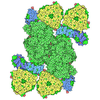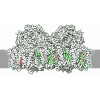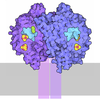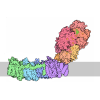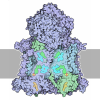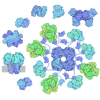[English] 日本語
 Yorodumi
Yorodumi- PDB-9au4: Cryo-EM structure of a photosystem I variant containing an unusua... -
+ Open data
Open data
- Basic information
Basic information
| Entry | Database: PDB / ID: 9au4 | ||||||||||||||||||
|---|---|---|---|---|---|---|---|---|---|---|---|---|---|---|---|---|---|---|---|
| Title | Cryo-EM structure of a photosystem I variant containing an unusual plastoquinone derivative in its electron transfer chain | ||||||||||||||||||
 Components Components |
| ||||||||||||||||||
 Keywords Keywords | PHOTOSYNTHESIS / cyanobacteria / photosystem I / MenB / phylloquinone / plastoquinone / benzoquinone / naphthoquinone / redox potential | ||||||||||||||||||
| Function / homology |  Function and homology information Function and homology informationphotosystem I reaction center / photosystem I / photosynthetic electron transport in photosystem I / photosystem I / chlorophyll binding / plasma membrane-derived thylakoid membrane / photosynthesis / 4 iron, 4 sulfur cluster binding / electron transfer activity / oxidoreductase activity ...photosystem I reaction center / photosystem I / photosynthetic electron transport in photosystem I / photosystem I / chlorophyll binding / plasma membrane-derived thylakoid membrane / photosynthesis / 4 iron, 4 sulfur cluster binding / electron transfer activity / oxidoreductase activity / magnesium ion binding / metal ion binding / plasma membrane Similarity search - Function | ||||||||||||||||||
| Biological species |  | ||||||||||||||||||
| Method | ELECTRON MICROSCOPY / single particle reconstruction / cryo EM / Resolution: 2.03 Å | ||||||||||||||||||
 Authors Authors | Gisriel, C.J. / Vasily, K. / Iwig, D.F. / Russell, B.P. / Vinyard, D.J. / Golbeck, J.H. / Brudvig, G.W. / Lakshmi, K.V. | ||||||||||||||||||
| Funding support |  United States, 5items United States, 5items
| ||||||||||||||||||
 Citation Citation |  Journal: Sci Adv / Year: 2024 Journal: Sci Adv / Year: 2024Title: Cryo-EM structure of a photosystem I variant containing an unusual plastoquinone derivative in its electron transfer chain. Authors: Christopher J Gisriel / Vasily Kurashov / David F Iwig / Brandon P Russell / David J Vinyard / Gary W Brudvig / John H Golbeck / K V Lakshmi /  Abstract: Photosystem I (PS I) is a light-driven oxidoreductase responsible for converting photons into chemical bond energy. Its application for renewable energy was revolutionized by the creation of the MenB ...Photosystem I (PS I) is a light-driven oxidoreductase responsible for converting photons into chemical bond energy. Its application for renewable energy was revolutionized by the creation of the MenB deletion (Δ) variant in the cyanobacterium sp. PCC 6803, in which phylloquinone is replaced by plastoquinone-9 with a low binding affinity. This permits its exchange with exogenous quinones covalently coupled to dihydrogen catalysts that bind with high affinity, thereby converting PS I into a stable solar fuel catalyst. Here, we reveal the 2.03-Å-resolution cryo-EM structure of a recent MenB variant of PS I. The quinones and their binding environment are analyzed in the context of previous biophysical data, thereby enabling a protocol to solve future PS I hybrids and constructs from this genetically tractable cyanobacterium. | ||||||||||||||||||
| History |
|
- Structure visualization
Structure visualization
| Structure viewer | Molecule:  Molmil Molmil Jmol/JSmol Jmol/JSmol |
|---|
- Downloads & links
Downloads & links
- Download
Download
| PDBx/mmCIF format |  9au4.cif.gz 9au4.cif.gz | 2.5 MB | Display |  PDBx/mmCIF format PDBx/mmCIF format |
|---|---|---|---|---|
| PDB format |  pdb9au4.ent.gz pdb9au4.ent.gz | Display |  PDB format PDB format | |
| PDBx/mmJSON format |  9au4.json.gz 9au4.json.gz | Tree view |  PDBx/mmJSON format PDBx/mmJSON format | |
| Others |  Other downloads Other downloads |
-Validation report
| Summary document |  9au4_validation.pdf.gz 9au4_validation.pdf.gz | 16.3 MB | Display |  wwPDB validaton report wwPDB validaton report |
|---|---|---|---|---|
| Full document |  9au4_full_validation.pdf.gz 9au4_full_validation.pdf.gz | 17.1 MB | Display | |
| Data in XML |  9au4_validation.xml.gz 9au4_validation.xml.gz | 309.5 KB | Display | |
| Data in CIF |  9au4_validation.cif.gz 9au4_validation.cif.gz | 409.8 KB | Display | |
| Arichive directory |  https://data.pdbj.org/pub/pdb/validation_reports/au/9au4 https://data.pdbj.org/pub/pdb/validation_reports/au/9au4 ftp://data.pdbj.org/pub/pdb/validation_reports/au/9au4 ftp://data.pdbj.org/pub/pdb/validation_reports/au/9au4 | HTTPS FTP |
-Related structure data
| Related structure data |  43843MC M: map data used to model this data C: citing same article ( |
|---|---|
| Similar structure data | Similarity search - Function & homology  F&H Search F&H Search |
- Links
Links
- Assembly
Assembly
| Deposited unit | 
|
|---|---|
| 1 |
|
- Components
Components
-Photosystem I P700 chlorophyll a apoprotein ... , 2 types, 6 molecules GaAHbB
| #1: Protein | Mass: 83036.398 Da / Num. of mol.: 3 / Source method: isolated from a natural source / Source: (natural)  #2: Protein | Mass: 81298.453 Da / Num. of mol.: 3 / Source method: isolated from a natural source / Source: (natural)  |
|---|
-Protein , 1 types, 3 molecules NcC
| #3: Protein | Mass: 8837.261 Da / Num. of mol.: 3 / Source method: isolated from a natural source / Source: (natural)  |
|---|
-Photosystem I reaction center subunit ... , 8 types, 24 molecules OdDPeEQfFRiISjJTkKUlLVmM
| #4: Protein | Mass: 15663.749 Da / Num. of mol.: 3 / Source method: isolated from a natural source / Source: (natural)  #5: Protein | Mass: 8154.086 Da / Num. of mol.: 3 / Source method: isolated from a natural source / Source: (natural)  #6: Protein | Mass: 18267.082 Da / Num. of mol.: 3 / Source method: isolated from a natural source / Source: (natural)  #7: Protein/peptide | Mass: 4414.148 Da / Num. of mol.: 3 / Source method: isolated from a natural source / Source: (natural)  #8: Protein/peptide | Mass: 4535.415 Da / Num. of mol.: 3 / Source method: isolated from a natural source / Source: (natural)  #9: Protein | Mass: 9312.122 Da / Num. of mol.: 3 / Source method: isolated from a natural source / Source: (natural)  #10: Protein | Mass: 16631.795 Da / Num. of mol.: 3 / Source method: isolated from a natural source / Source: (natural)  #11: Protein/peptide | Mass: 3382.063 Da / Num. of mol.: 3 / Source method: isolated from a natural source / Source: (natural)  |
|---|
-Sugars , 2 types, 6 molecules 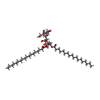
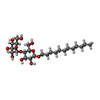

| #25: Sugar | | #26: Sugar | |
|---|
-Non-polymers , 14 types, 1305 molecules 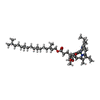
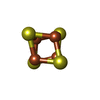
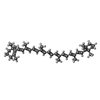
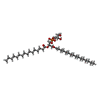
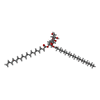






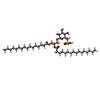













| #12: Chemical | ChemComp-CLA / #13: Chemical | ChemComp-A1AGD / Mass: 414.664 Da / Num. of mol.: 6 / Source method: obtained synthetically / Formula: C28H46O2 #14: Chemical | ChemComp-SF4 / #15: Chemical | ChemComp-BCR / #16: Chemical | ChemComp-LHG / #17: Chemical | ChemComp-LMG / #18: Chemical | #19: Chemical | #20: Chemical | ChemComp-ECH / #21: Chemical | ChemComp-CA / #22: Chemical | #23: Chemical | ChemComp-ZEX / ( #24: Chemical | ChemComp-SQD / #27: Water | ChemComp-HOH / | |
|---|
-Details
| Has ligand of interest | Y |
|---|---|
| Has protein modification | Y |
-Experimental details
-Experiment
| Experiment | Method: ELECTRON MICROSCOPY |
|---|---|
| EM experiment | Aggregation state: PARTICLE / 3D reconstruction method: single particle reconstruction |
- Sample preparation
Sample preparation
| Component | Name: MenB Photosystem I / Type: COMPLEX / Entity ID: #1-#11 / Source: NATURAL |
|---|---|
| Source (natural) | Organism:  |
| Buffer solution | pH: 8.3 |
| Specimen | Conc.: 1 mg/ml / Embedding applied: NO / Shadowing applied: NO / Staining applied: NO / Vitrification applied: YES |
| Vitrification | Cryogen name: ETHANE |
- Electron microscopy imaging
Electron microscopy imaging
| Experimental equipment |  Model: Titan Krios / Image courtesy: FEI Company |
|---|---|
| Microscopy | Model: TFS KRIOS |
| Electron gun | Electron source:  FIELD EMISSION GUN / Accelerating voltage: 300 kV / Illumination mode: FLOOD BEAM FIELD EMISSION GUN / Accelerating voltage: 300 kV / Illumination mode: FLOOD BEAM |
| Electron lens | Mode: BRIGHT FIELD / Nominal defocus max: 2000 nm / Nominal defocus min: 800 nm |
| Image recording | Electron dose: 40.2 e/Å2 / Film or detector model: GATAN K3 (6k x 4k) |
- Processing
Processing
| EM software | Name: PHENIX / Version: 1.20.1_4487: / Category: model refinement |
|---|---|
| CTF correction | Type: PHASE FLIPPING AND AMPLITUDE CORRECTION |
| 3D reconstruction | Resolution: 2.03 Å / Resolution method: FSC 0.143 CUT-OFF / Num. of particles: 375816 / Symmetry type: POINT |
 Movie
Movie Controller
Controller


 PDBj
PDBj